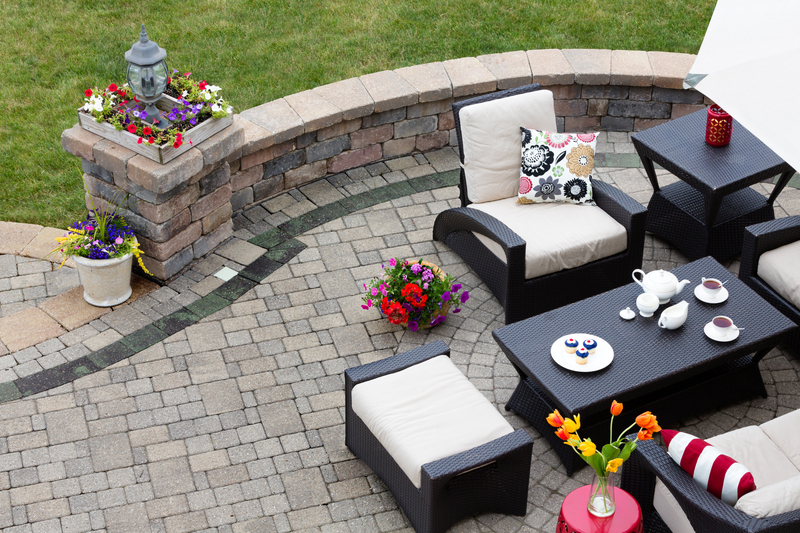Garden Architecture: Refined Hedge Trimming Shapes and Techniques
Posted on 11/06/2025
Garden Architecture: Refined Hedge Trimming Shapes and Techniques
Garden architecture is not merely about planting flowers or placing ornaments--it's the thoughtful orchestration of nature and design to craft captivating outdoor spaces. Among the crucial aspects of sophisticated landscape design is the art of hedge trimming. Well-trimmed hedges define boundaries, provide privacy, and serve as living sculptures that lend visual interest throughout the year. In this comprehensive guide, you'll discover everything you need to know about refined hedge trimming shapes and expert techniques to elevate your garden's architectural character.
The Role of Hedges in Garden Architecture
The concept of using hedges in landscape architecture can be traced back to the elegant parterres and sweeping vistas of European chateaux, where sculpted greenery showcased a mastery over nature. Modern garden architecture employs hedges for a diverse array of purposes:
- Defining garden rooms and boundaries
- Offering privacy from neighboring properties
- Creating focal points and framing garden vistas
- Sheltering delicate plants from wind and weather
- Providing structure and year-round greenery
The deliberate choice of hedge varieties and shapes can determine the character and function of your outdoor sanctuary--be it formal, whimsical, or modern.

Popular Hedge Trimming Shapes for Garden Design
Refined hedge trimming shapes transform ordinary shrubs into living architecture. Here are the top shapes used in contemporary and classical garden design:
1. Geometric Hedge Forms
- Cubes and Rectangles: Exude orderliness and are ideal for borders or edging pathways.
- Spheres: Add organic contrast to linear elements in a landscape.
- Pyramids and Cones: Amplify vertical interest and mark key spots in the garden.
These formal shapes require precise hedge trimming techniques, making them a showcase of a seasoned gardener's skill.
2. Topiary Artworks
Topiary is the art of sculpting hedges into ornamental forms, ranging from animals and spirals to intricate patterns. This advanced form of garden architecture can become a unique focal point or conversation piece in any landscape.
3. Flowing Curves and Wavy Lines
For a softer, more naturalistic look, many designers choose wavy or undulating hedge lines. These forms evoke a sense of movement and are especially appealing in contemporary and cottage-style gardens.
4. Tapered Hedges (A-line or Trapezoidal)
The most robust and sustainable hedge shape is the trapezoidal or A-line form--wider at the base than the top. This technique ensures that sunlight reaches all levels, promoting lush growth from top to bottom and preventing bare patches.
5. Cloud Pruning (Niwaki)
Cloud pruning, or niwaki, is a Japanese technique that shapes shrubs into rounded clumps or "clouds" on visible stems. This refined trimming style brings a serene, sculptural elegance to modern gardens.
Essential Principles of Refined Hedge Trimming
To achieve flawless hedges, expert gardeners follow specific rules and guidelines derived from generations of landscape artistry. Here are the most important principles:
- Plan Before You Prune: Visualize the desired shape and use string lines or frames for accuracy.
- Start with Healthy Hedges: Only trim robust, well-rooted plants--neglected or sickly shrubs respond poorly to heavy pruning.
- Choose the Right Tools: Use sharp, clean shears or powered trimmers for smooth, crisp cuts. Specialized topiary shears deliver detail for intricate shapes.
- Mind the Growth Cycle: Trim hedges when they're actively growing, and avoid cutting during periods of drought or frost.
- Maintain a Taper: Always keep the lower portion slightly broader than the top to permit even light distribution.
- Trim Lightly and Often: Frequent, gentle trimming encourages denser growth and allows easier correction of mistakes.
Step-by-Step Techniques for Professional Hedge Trimming
1. Assess Your Hedge
Examine your hedge's species and condition. Fast-growing hedges, such as privet, boxwood, or yew, respond well to regular trimming. Slower varieties may need less frequent attention but require careful shaping to develop an attractive structure over multiple seasons.
2. Prepare Your Tools and Safety Gear
- Hand shears for precision work
- Electric or cordless trimmers for major shaping
- Spirit level, string, or canes for straight lines
- Safety goggles and gloves for protection
Ensure everything is sharpened and free of disease to minimize plant stress.
3. Mark Out the Desired Shape
Use stakes and string to outline straight edges, and form wire templates for curves or spheres. For complex topiary, create cardboard silhouettes as guides.
4. Begin Shaping from the Bottom Up
Start by trimming the sides from the base upward, always working your way to the top. This approach ensures that clippings fall away and keeps your line of sight clear. When forming a cube, rectangle, or A-line hedge:
- Use a long level or taut strings to maintain straight, even lines
- Check both sides periodically to ensure symmetry
5. Taper the Hedge for Health
Remember to taper the hedge--the base should be wider than the top by about 2-4 cm per meter of height. This allows full sunlight to reach all levels, producing lush, even growth. Failure to do so can cause lower branches to thin out and die.
6. Focus on the Top Last
Once sides are satisfactorily shaped, clip the top for a clean, flat finish. For conical, spherical, or topiary shapes, use rotating movements and continually step back to assess the outline from all angles.
Advanced Techniques for Ornamental and Artistic Hedges
Topiary Creation
Topiary isn't limited to formal palaces--it's a dynamic element in modern garden architecture, lending a playful or elegant touch. For beginners, start with simple geometric shapes. Advanced practitioners can attempt spirals, wildlife forms, or complex abstract designs. The key is patience--most topiary takes several seasons to reach perfection. Employ specialized wire frames as guides and trim little but often to nudge the plant gradually into form.
Cloud Pruning
Cloud pruning produces dreamlike, floating shapes evocative of clouds. Begin by selecting a shrub with attractive branching, such as box or Japanese holly. Remove inner growth to emphasize the main structural branches, then trim clusters of leaves into tight, rounded pads. Revisit the form regularly to maintain its ethereal shape.
Espalier and Pleaching
If you seek living walls and elaborate screens, consider espalier (training plants flat against a frame) or pleaching (weaving branches together). These time-honored methods require rigging horizontal wires and guiding shoots for several years but result in truly dramatic, refined garden elements.
Choosing Hedge Plants for Architectural Impact
Not every shrub is suitable for elaborate hedge clipping. For long-term success, pick varieties that tolerate regular trimming and maintain dense foliage:
- Box (Buxus sempervirens): The classic choice for small hedges and topiary shapes.
- Yew (Taxus baccata): Tolerates heavy shaping and clipping, perfect for formal structures and cloud pruning.
- Privet (Ligustrum): Fast-growing and forgiving--ideal for taller privacy screens.
- Hornbeam (Carpinus betulus): Holds its leaves into winter, offering year-round screening and robust shape.
- Beech (Fagus sylvatica): Foliage turns beautiful copper hues in fall; great for tall architectural hedges.
Consult with a local nursery about climate suitability and growth rates to ensure your investment yields striking results.
Common Hedge Trimming Mistakes to Avoid
Even with the best intentions, many gardeners fall into common mistakes that can undermine their efforts:
- Ignoring the Taper: Vertical sides block sunlight, leading to unhealthy, thin, or bald lower branches.
- Cutting at the Wrong Time: Heavy trimming in late summer or winter can injure plants or expose them to frost damage.
- Over-trimming Young Hedges: Excessive shaping before the plant is established can impede healthy, dense growth.
- Using Dull or Dirty Tools: This can create ragged, disease-prone wounds on branches.
- Neglecting Cleanup: Leftover clippings can smother lower leaves, foster disease, and make the garden look untidy.
Seasonal Care and Maintenance for Refined Hedges
Excellent garden architecture requires ongoing attention. Follow these seasonal tips:
- Spring: Hard-prune overgrown or neglected hedges. Encourage fresh growth with light feeding and mulching.
- Summer: Maintain shapes with frequent light trims, especially for fast-growing varieties. Water in dry spells.
- Autumn: Give a final shaping before winter. Inspect for disease and remove debris from hedge bases.
- Winter: Avoid heavy trimming, but clear snow loads from tops to prevent breakage.
Consistent, mindful care ensures that hedge architecture remains the backbone of your garden, season after season.

Inspiring Ideas for Your Own Garden Hedge Architecture
- Hedge Labyrinths: Craft meandering paths or mini mazes using low, tightly clipped box or yew.
- Mixed Species Hedges: Combine contrasting foliage colors and textures for visual interest and biodiversity.
- Hedge Fountains and Clipped Waves: Recreate the look of flowing water or gentle waves with undulating forms.
- Accentuate Entrances: Frame garden gates or doors with paired cones, spirals, or spheres.
- Living Garden Walls: For urban spaces, use pleached or espaliered hedge screens as privacy barriers.
Conclusion: Elevate Your Landscape with Artistic Hedge Trimming
Hedge trimming is where horticulture meets artistry. By mastering refined shapes and advanced techniques, you can transform hedges from humble barriers to living sculptures that give your garden structure, rhythm, and year-round appeal. Whether your vision embraces classical symmetry, whimsical topiary, or contemporary organic forms, the right approach will help you realize a stylish, enduring garden architecture. Embrace the discipline--trim a little, but trim often, and your green masterpieces will stand proudly for generations to come.
For more tips on refined hedge trimming, innovative garden architecture, or landscape design inspiration, explore our other expert guides and let your creativity take root!

